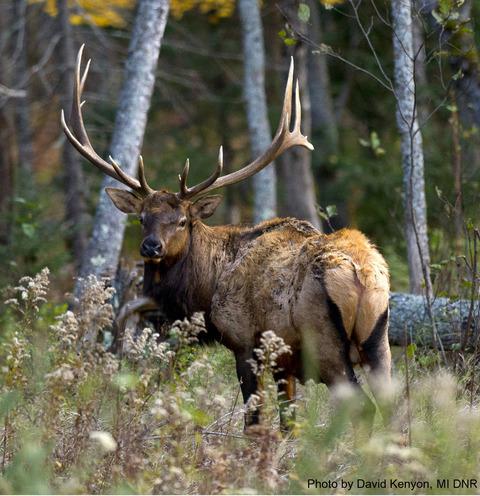当前位置:
X-MOL 学术
›
J. Appl. Ecol.
›
论文详情
Our official English website, www.x-mol.net, welcomes your
feedback! (Note: you will need to create a separate account there.)
Integrating socioecological suitability with human–wildlife conflict risk: Case study for translocation of a large ungulate
Journal of Applied Ecology ( IF 5.0 ) Pub Date : 2021-09-07 , DOI: 10.1111/1365-2664.14021 Nicholas P. McCann 1 , Eric M. Walberg 2 , James D. Forester 1 , Michael W. Schrage 3 , David C. Fulton 1, 4 , Mark A. Ditmer 1, 5
中文翻译:

将社会生态适宜性与人类-野生动物冲突风险相结合:大型有蹄类动物易地的案例研究
更新日期:2021-09-07
Journal of Applied Ecology ( IF 5.0 ) Pub Date : 2021-09-07 , DOI: 10.1111/1365-2664.14021 Nicholas P. McCann 1 , Eric M. Walberg 2 , James D. Forester 1 , Michael W. Schrage 3 , David C. Fulton 1, 4 , Mark A. Ditmer 1, 5
Affiliation

|
- Translocations are essential for re-establishing wildlife populations. As they sometimes fail, it is critical to assess factors that influence their success pre-translocation.
- Socioecological suitability models (SESMs) integrate social acceptance and ecological suitability to enable identification of areas where wildlife populations will expand, which makes it likely that SESMs will also be useful for predicting translocation success.
- To inform site selection for potential elk Cervus canadensis reintroduction to north-eastern Minnesota, United States, we developed broadscale maps of social acceptance from surveys of local residents and landowners, animal use equivalence (AUE) from forage measured in the field and empirical conflict risk from geospatial data. Resulting SESMs integrated social acceptance favourability scores, AUE and conflict risk, and weighted SESMs showed the relative influences of acceptance and conflict.
- Social acceptance was positive for local residents and landowners (mean ≥ 5.4; scale of 1–7). AUE (scaled to an elk home range) ranged between 1 and 9 elk/16 km2 during winter, and from 14 to 83 elk/16 km2 during summer. Human–elk conflict risk was low (mean ≤ 0.10; scaled 0–1), increasing from north to south. Geographical distributions differed for social acceptance, AUE and conflict risk, and weighted SESMs revealed unsuitable areas that were otherwise obscured.
- Synthesis and applications. Integrating human–wildlife conflict risk into SESMs shows where social acceptance of translocated species is likely to erode, even where viewed favourably pre-translocation, to inform translocation planning by highlighting interactions between key factors. Such integrated models supplement existing reintroduction biology frameworks by supporting decision-making and knowledge development. In north-eastern Minnesota, natural resource managers who are considering elk reintroductions are using SESMs reported here to identify where human–elk conflict is unlikely to result in an isolated elk population and where addressing concerns for area residents about conflict risk is essential.
中文翻译:

将社会生态适宜性与人类-野生动物冲突风险相结合:大型有蹄类动物易地的案例研究
- 易位对于重建野生动物种群至关重要。由于它们有时会失败,因此在易位前评估影响其成功的因素至关重要。
- 社会生态适宜性模型 (SESM) 将社会接受度和生态适宜性相结合,以识别野生动物种群将扩大的区域,这使得 SESM 也可能有助于预测易地成功。
- 为了为可能将加拿大鹿重新引入美国明尼苏达州东北部的麋鹿马鹿重新引入地点选择提供信息,我们根据当地居民和土地所有者的调查、实地测量的草料的动物使用等效性 (AUE) 和经验冲突风险绘制了广泛的社会接受度地图来自地理空间数据。结果 SESM 综合了社会接受好感度分数、AUE 和冲突风险,加权 SESM 显示了接受和冲突的相对影响。
- 当地居民和土地所有者的社会接受度是积极的(平均值 ≥ 5.4;1-7 级)。AUE(按比例调整到麋鹿家范围)在冬季介于 1 到 9 只麋鹿/16 km 2 之间,在夏季介于 14 到 83 只麋鹿/16 km 2之间。人与麋鹿冲突的风险较低(平均值≤ 0.10;按 0-1 分等级),从北向南增加。社会接受度、AUE 和冲突风险的地理分布不同,加权 SESM 揭示了不合适的区域,否则会被掩盖。
- 合成与应用。将人类与野生动物冲突风险纳入 SESM 表明,社会对易地物种的接受度可能会下降,即使在易地前被认为是有利的,通过突出关键因素之间的相互作用来为易地规划提供信息。这种集成模型通过支持决策和知识开发来补充现有的再引入生物学框架。在明尼苏达州东北部,正在考虑重新引入麋鹿的自然资源管理人员正在使用此处报告的 SESM 来确定人与麋鹿冲突不太可能导致孤立的麋鹿种群的地方,以及解决该地区居民对冲突风险的担忧至关重要的地方。











































 京公网安备 11010802027423号
京公网安备 11010802027423号